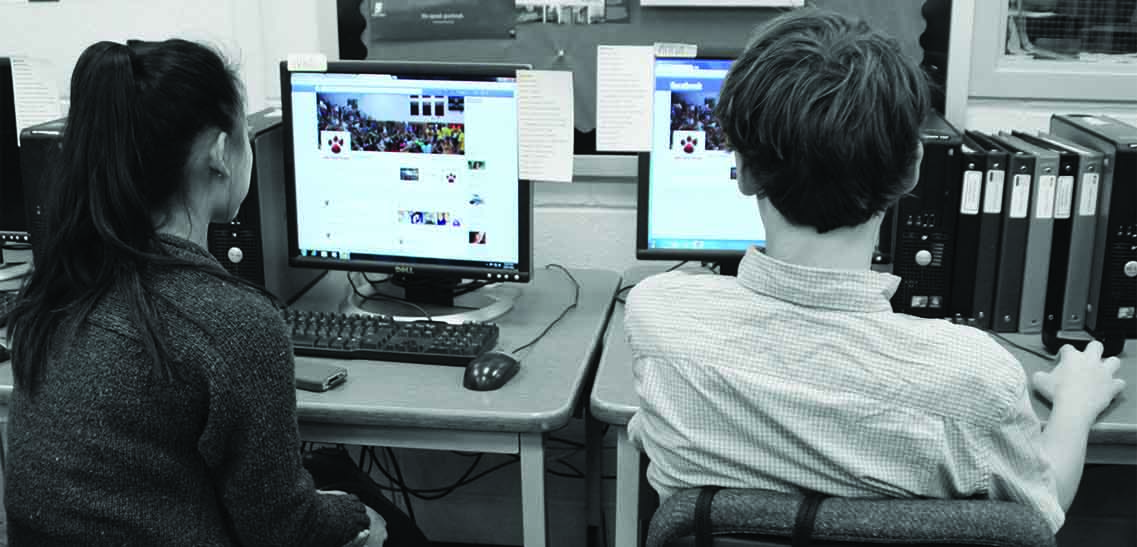
Photo illustration by Ashley Hocking
By Zia Kelly
Last month, USD 497 made the decision to unblock the full use of YouTube and Facebook, allowing students to browse these sites at all times.
Two years ago, USD 497 blocked Facebook for everyone, and YouTube for students. Students and teachers alike dealt with limitations that some argued hindered the educational value of the internet.
When assistant superintendent Jerri Kemble was hired in July, the district had already begun discussing the policy regarding some of the blocked websites.
The district finally took action early in the school year to make these websites available for student use.
“Social media is not going to go away,” Kemble said. “It’s an area that we can really help kids become responsible in.”
While the decision may have seemed surprising to students and teachers, the motion to unblock Facebook and YouTube has existed within the district for some time. But it really picked up traction when Kemble joined the administration and took the initiative to get approval to take action.
Many factors were considered when making decision to unblock these two websites, but perhaps the most significant factor was the impact social media has on society and its newfound ties with education.
“The catalyst for me was hearing from principals that we really need to open these websites up so that we can use them for education, this is the way we learn today,” Kemble said. “Do you hear people talk about 21st century learning? Yeah, well we are already 13 years into the 21st century, so we need to be using these kinds of things, because we need to make it engaging for you.”
Although the opposition is obvious, with the distractions the websites can provide, the district is confident that their involvement will ease the minds of skeptics.
“In school, we put kids out on the playground to play, and we send adults out there to monitor what they are doing, and sometimes they do things they shouldn’t do,” Kemble said. “We help them understand what they should be doing. We help them learn the right way.”
Teachers and administrators see the use of the websites as a new resources for higher learning.
“I see great potential with YouTube especially,” Kemble said. “Sometimes I will get a problem, maybe with a new computer program or something, and I can just go to YouTube and look it up. I think that kids can use it that way too.”
Film teacher Jeff Kuhr plans to use YouTube for his students projects.
“I think in some ways it’s cool for my class, it gives students the opportunity to look up different sound effects and different music they might want to think about including in their films,” Kuhr said. “Although they are encouraged to use music that has no copyright, there is some of that on YouTube as well. It does give them the opportunity to look at that and hear it.”
Marketing and Entrepreneurship instructor Lisa Burns plans on using Facebook profiles as examples for her business classes.
“We can look up and see how businesses have created Facebook pages and use them as examples,” Burns said.
In journalism Barbara Tholen’s classroom, the publication staffs have countless uses for Facebook and YouTube. The Budget maintains a full website, including videos uploaded to YouTube and direct connections with social networking sites. The Red & Black yearbook staff also maintains a Twitter account and posts additional material.
While the accessibility to these resources has beneficial implications, the realistic effects have to be taken into account.
“I would be concerned that it’s going to distract the students, like Twitter does, right now,” Burns said.
Social networking is not the only classroom distraction. There is also a worry about YouTube videos causing problems.
“I don’t understand how the security will work around that if those types of videos will be blocked,” Burns said. “Also, if it’s causing any sort of harassment type issues with videos that may be inappropriate and offensive to other students.”
While online bullying and harassment are growing problems in a technology driven society, part of the district’s decision was based in the grounds that it could have an effect in healing this issue.
“[Opening Facebook and YouTube to schools] is a good way to let the school know that those things are happening, and then we can address them,” Kemble said.
When it comes to internet access, Kemble said the district must abide by safety regulations of online content by censoring anything the district believes is inappropriate.
Because the school receives funding from the government, it has to be careful of what content it allows students to view. The districts’ fire walls are constantly looking for and blocking websites that are deemed inappropriate.
When first approached about the unblocking of Facebook and YouTube, sophomore Andrew Bell addressed the step the district made regarding student content access.
“In light of recent current events, such as the NSA surveillance scandal and the foreign wiretaps by the United States, it’s nice to see a change in pace: the school moving away from censorship and moving toward more freedom for its students,” Bell said.


